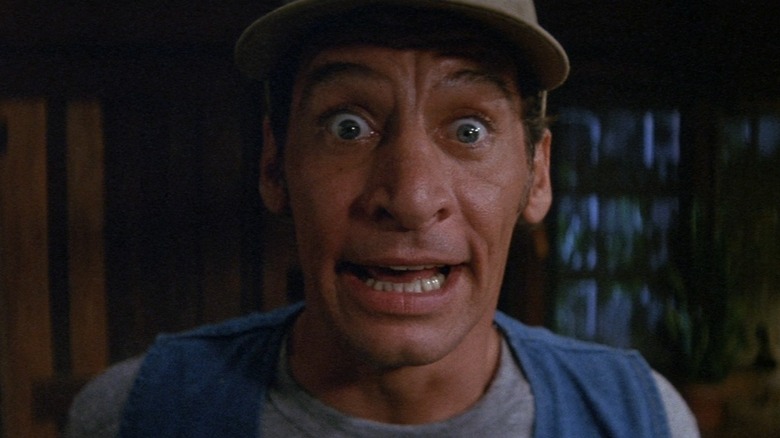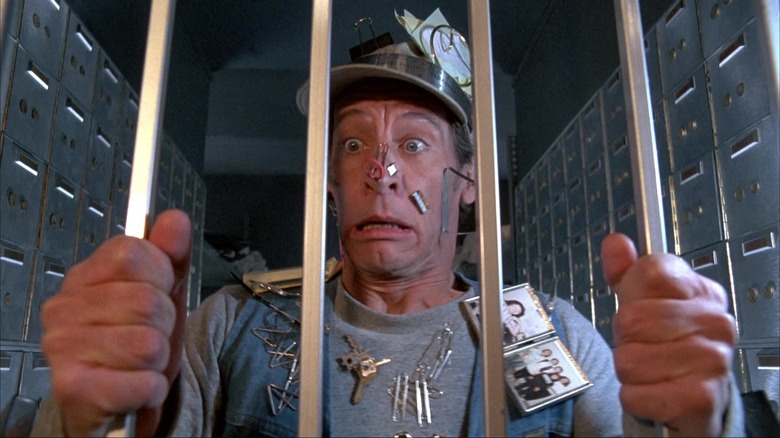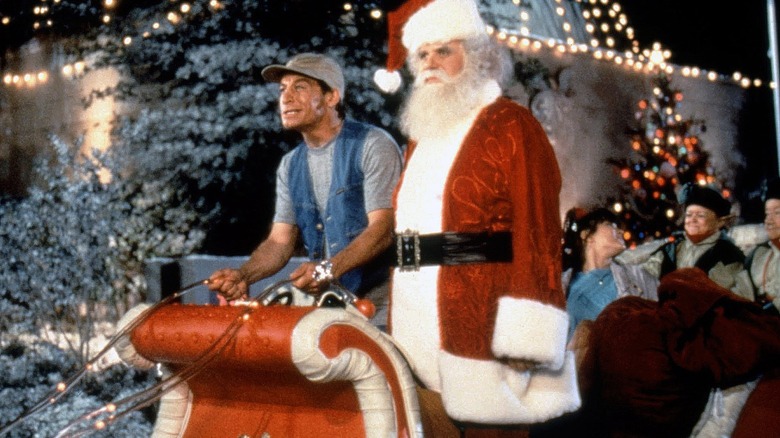The Correct Order To Watch The Ernest Movies
The creation of Ernest P. Worrell, played by actor/comedian Jim Varney, was novel for an advertising-saturated age. The idea was that the character's creators — John R. Cherry III, his business partner Jerry Carden, and Varney — would farm out their pre-made mascot to whatever product or service that might want him, and Ernest would hawk their wares. He wasn't invented for any one particular business. He was invented to be a pitchman-for-hire, and the Ernest ads all followed a similar format (Ernest addressing the camera in a rural setting, calling the viewer "Vern"), making the commercial spots low-budget and instantly universal. Ernest was hired by the Coca-Cola Company to sell Sprite, but would also appear in ads for local businesses like the Cerrito Auto Square. Ernest was very, very popular.
Eventually, the Ernest ads became so huge and ubiquitous that the character began to bleed over into feature films and TV shows. Ernest was a media personality writ large, living across multiple screens like an impish, un-killable blue-collar Max Headroom. Some found Varney's bug-eyed shtick to be a little abrasive, as a lot of the character is based on Varney's infinite capacity for outsize mugging. Ernest, however, is a decent, gentle character and his propensity for destruction stems from his clumsiness, not cruelty or spite. Even as a lad, he was sensitive and caring. As cunning as a fox and as slippery as a herring. Ernest may be a boob, but he's a kind soul.
12 Ernest feature films and TV specials were released from 1985 to 1998 and span both theaters and the straight-to-video market. A thirteenth film, "Ernest the Pirate," was scrapped when Varney died in 2000 at the age of 50.
Let us take a trip around the Worrell.
The release order
Starting with a straight-to-video introduction to the character, the release order is as follows:
- "Knowhutimean? Hey, Vern! It's My Family Album" (1983)
- "Dr. Otto and the Riddle of the Gloom Beam" (1985)
- "Ernest Goes to Camp" (1987)
- "Ernest Save Christmas" (1988)
- "Ernest Goes to Jail" (1990)
- "Ernest Scared Stupid" (1991)
- "Ernest Rides Again" (1993)
- "Your World as I See It" (1994)
- "Ernest Goes to School" (1994)
- "Slam Dunk Ernest" (1995)
- "Ernest Goes to Africa" (1997)
- "Ernest in the Army" (1998)
"Family Album" is a 57-minute anthology film of short sketches, monologues, and comedic bits all performed by Varney. One of his skills as a comedian was inventing multiple characters, and Varney would play Auntie Nelda, Astor Clement, Bunny Jeanette Rodgers, and a dozen other members of the Kentuckian Worrell clan. The 1994 video "Your World as I See It" was a 27-minute special with a similar structure, only with a slightly more philosophical bent.
"Dr. Otto and the Riddle of the Gloom Beam" was also structured like an anthology. Dr. Otto (Varney) is a supervillain who has constructed a Gloom Beam that he intends to fire into banks and erase all financial information. He also has a transformation booth that will disguise him as anyone, and Dr. Otto uses it to transform into Varney's various personae. So transformed, Dr. Otto then visits the sites of his Goom Beam attacks to foil the heroic counterattacks by Lance Sterling (Mike R. Mueller). The tone of "Dr. Otto" is dark and surreal, and it barely coheres as a feature film.
Between his first special, his film, and his many, many TV commercials, the time finally came to give Ernest his own movie in ... well, in earnest. Along came the character's biggest hit, "Ernest Goes to Camp."
Other Ernest ephemera
There was also a 1988 sketch comedy show for kids called "Hey, Vern, It's Ernest!" The series incorporated one-liners, simple jokes, and comedy bits performed by Varney and by the rest of the cast. If one wanted to be a completist, one could squeeze the one-season, 12-episode series in between "Ernest Goes to Camp" and "Ernest Saves Christmas."
One might also do well to scour YouTube or other online video archives for the VHS specials "The Ernest Film Festival" (1986), "Hey Vern, Win $10,000 ... Or Just Count On Having Fun!" (1987), and two volumes of "Ernest's Greatest Hits" (1992). Those specials are mere video compilations of Ernest's advertisements. The sheer volume of Ernest commercials should communicate just how powerful the character was in the media landscape of the late 1980s.
Why Ernest? Why did this blue-collar boob capture the public's imagination so? Perhaps, arriving as he did in the waning days of the Reagan administration, he was an homage/parody of the "All-American Working Man" image so often referred to by conservative politicians. Ernest was hard-working, enterprising, and dim-witted, perhaps representing the "real America" that one so often hears about on campaign stumps. Ernest was a clown but also a hero, appealing to both sides of the political spectrum as a simultaneous sned-up and lionization. Also, Varney's rubbery face and energetic sense of humor were undeniably impressive, even if one found them to be really, really, really annoying.
"Ernest Saves Christmas" and "Ernest Goes to Jail" are also legitimately good movies. "Camp" and "Scared" are fine when you're about nine years old. "Dr. Otto" is a fascinating '80s curio worthy of sociological study. "Ernest Rides Again" ... has a catchy theme song, anyway. The rest are largely bland and redundant.
Consider Ernest. He once ruled our hearts.


